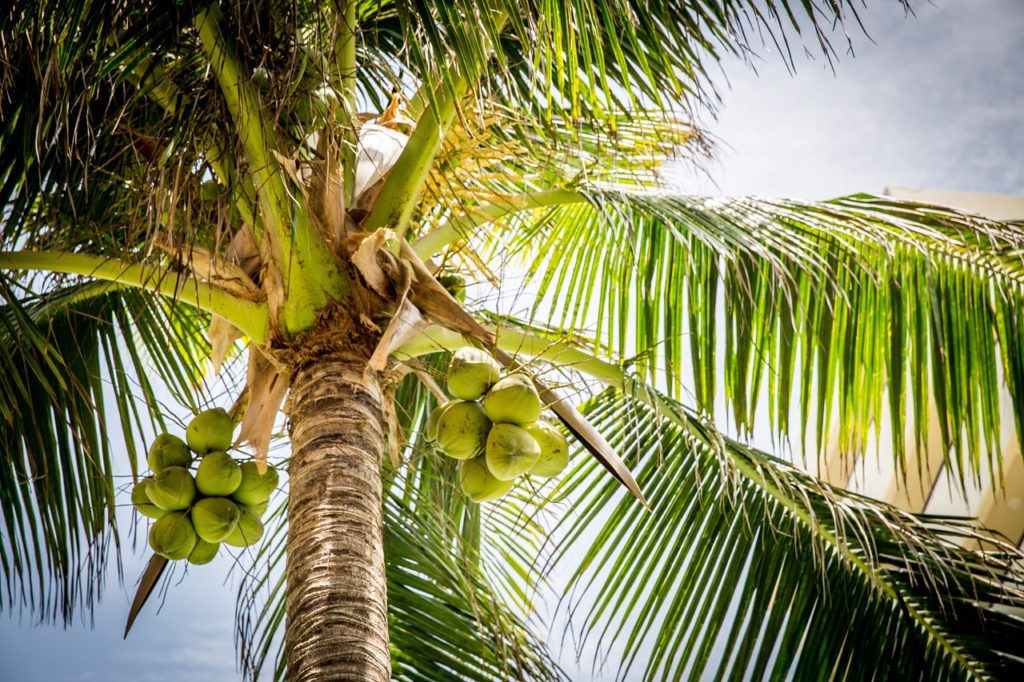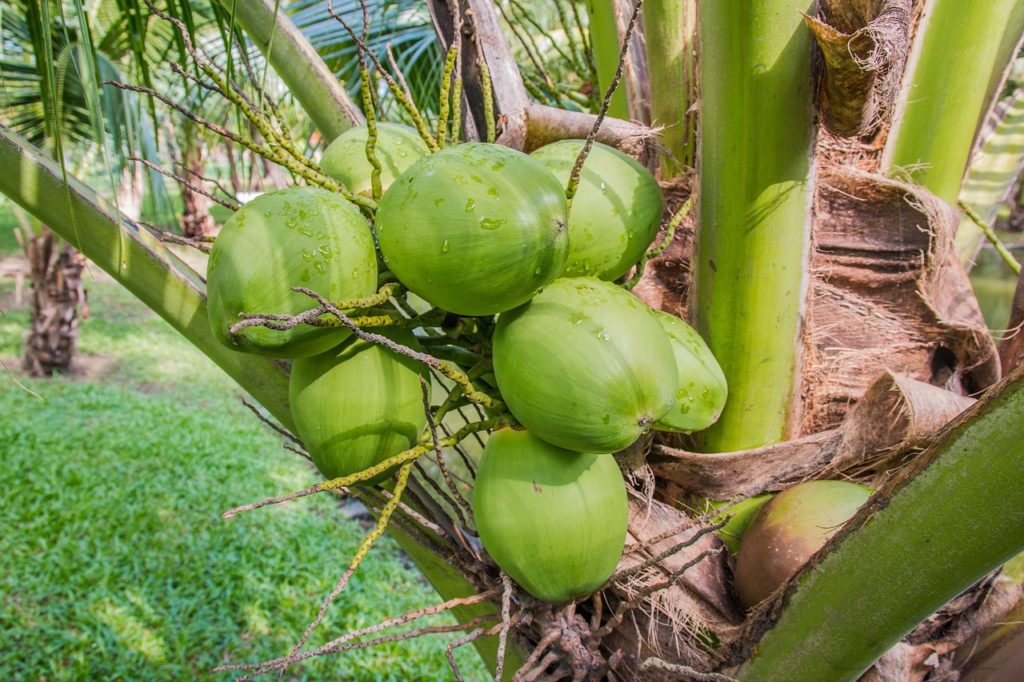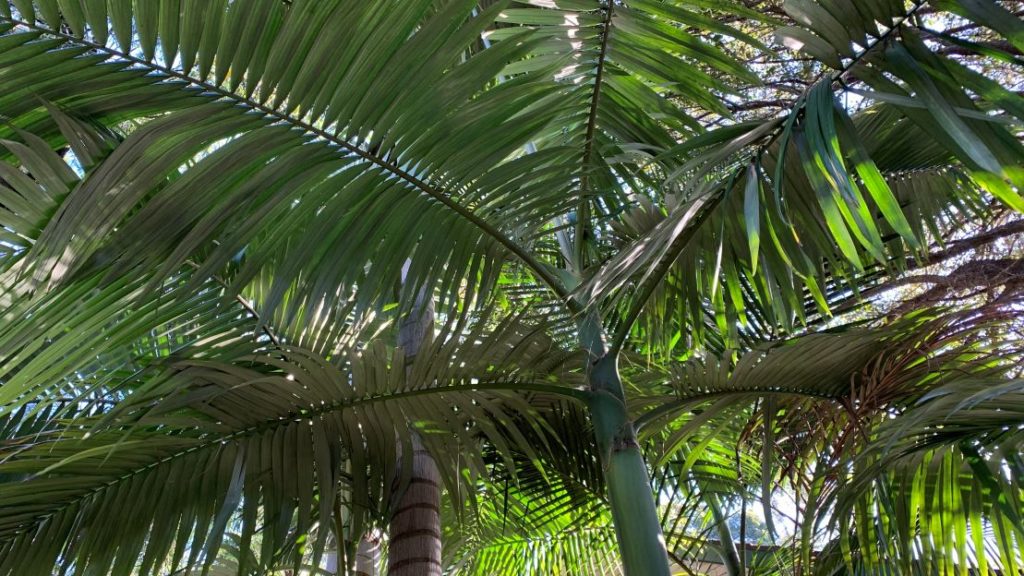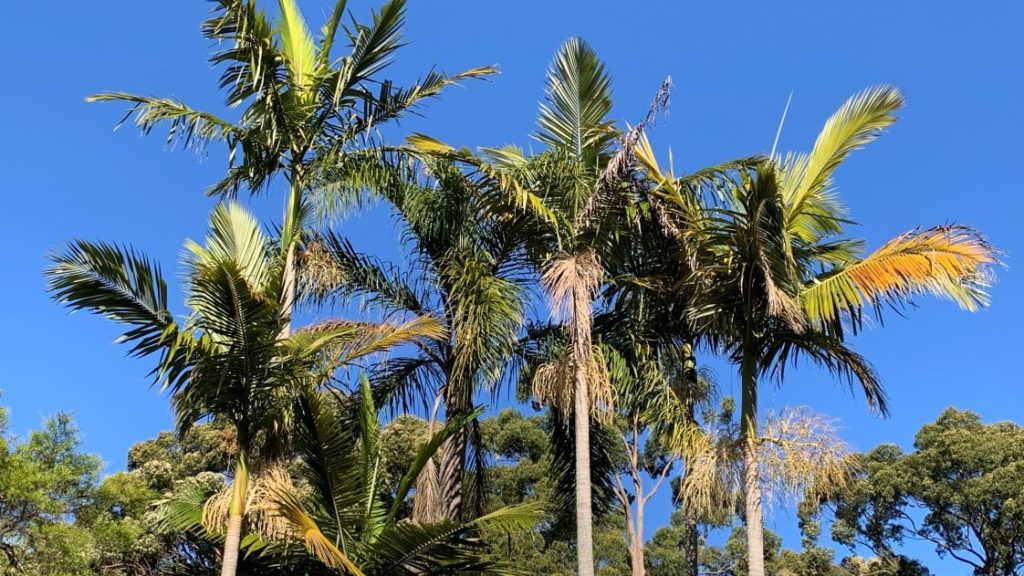Palm trees are a collection of trees under the class ‘Palmacae’ containing over 3000 species of palm. Coconut trees are a specific type of palm tree that grows coconuts. Coconut trees grow fast, tall and after around 6 years will start to produce coconuts. Palm trees can range from a few inches tall to 200 feet while palm trees will reach around 100 feet.
Palm trees can grow in a range of climates from Mediterranean to tropical climates. There is a species of palm to suit every situation and backyard size but coconut trees are more picky about where they are grown.

Coconut tree vs palm trees: Key differences
Check out this table below for a summary of the main differences between coconut trees and palm trees.
| Coconut Tree | Palm Tree | |
| Growth speed | 12-36 inches per year. Take 6-10 years to produce fruit. | Varies but as fast as 6 feet per year for the Carpenteria palm |
| Tree size | 60-100 feet tall, 20-30 feet wide. | Varying from a few inches to 200 feet for the Quindío wax palm |
| Water needs | Regular water is best but can be drought tolerant once established | Drought tolerant to high water needs |
| Climate | Tropical | Tropical and cooler climates |
| Sunlight | Full sun | Full sun to part shade for some rainforest species |
| Difficulty | Easy in tropical conditions | Easy-difficult depending on the species |
| Benefits | Produce coconuts | A variety is available for almost all locations |
| Leaf shape | Large, fan sized leaves, 25-35 inches in length | Ranging from 3 inches to 82 feet of the Rafia Regalis. |

Similarities between coconut trees vs palm trees
Check out the top similarities between coconut trees and palm trees if you are planning to grow them at home or are just curious to know more.
Leaves
All palm trees including both coconut trees and palm trees have leaves that are known as fronds. A central stem grows up and fans out usually with thin, strappy leaves. These can be as small as a few inches in the case of tiny indoor palms or as large as 10 feet for huge date palms.

Leaf colors of palms can range from a beautiful shade of green and yellow of the golden cane palm to a deep green of the date palm.
Many palm trees grow up from one central trunk with the outer leaves coming off, and leaving the trunk. Palm trees will continue to grow up from the center growing taller and taller producing flowers, seed pods and in the case of coconut trees they will grow coconuts.
Both palm trees and coconut trees are evergreen meaning they keep their leaves all year round. They will loose leaves gradually throughout the year which will brown and usually drop off on their own around the outside of the tree.

When I went to Samoa the island was covered in coconut trees. Coconut would be lying on the ground and the beach. The most important thing to remember about coconut trees, unlike palm trees is they are often carrying large heavy coconuts.

It is important to avoid walking under coconut trees when they are in fruit as a heavy coconut dropping down can be a huge problem. Admire them from afar and avoid walking under the canopy of a coconut tree.
Climate and location: Coconut tree vs palm tree
Coconut trees are hardy tree, common in tropical areas and tropical holiday islands and can live over 100 years. Old coconut trees will have large bases and thick trunks and will keep producing coconuts throughout the life of tree.
Coconut trees need a tropical climate to grow well and fruit vs palm trees where a species can be chosen to suit almost all climates including those in cooler regions.
Coconut trees are grown mostly in Florida in the USA due to the tropical climate and humidity. Other regions that are growing palms are not growing coconut trees but other species of palm that can tolerate a dryer or cooler climate.

Growth speed of a coconut tree vs palm tree
Coconut trees will grow around 12-36 inches per year depending on how much water and sunlight the tree gets. After around 6 years it will be ready to grow coconuts and can produce fruit for many years after this.
The speed of palm tree growth varies depending on the variety of palm. The Carpenteria palm for example can grow as fast as 6 feet per year. Other palms such as the golden cane palm grows slower with 1 foot of growth per year in great weather conditions.
Tree size: coconut tree vs palm tree
Coconut trees can grow 60-100 feet tall at their largest and 20-30 feet wide. A tropical island is the perfect place for this large plant and their canopy can stretch far taking over a large part of the beach.
The Quindío wax palm is the World’s largest palm. Found in montane forests of the Andes it can grow up t 200 feet high. The smallest palms include new dwarf varieties with Rhapis ‘super dwarf’ growing stems that are only 1-2 inches and leaves a few inches taller than that.
Benefits of a coconut tree vs palm tree
Coconut trees may seem like a great tree to grow if you have the space and live in the right climate. Coconut trees unlike other palms will eventually grow coconuts which is an exciting thing to be able to grow in your yard.
Once established coconut trees will be drought tolerant but they can take up a lot of room. If you have the space, time and commitment to wait 5 years for fruit a coconut tree might be worth a try.
Coconut tree vs palm tree | Summary
Coconut trees are a type of palm tree that will produce coconut fruit when grown in the right climate. Palm trees include a huge range of species and there is usually one that can suit the climate you are in. Golden cane palms are a hardy palm which won’t mind cooler weather. They have a beautiful yellow trunk and grow with little attention.
I am an accredited practicing dietitian, experienced gardener and a dedicated cook. I love writing and sharing my experience so you can learn from my successes and mistakes.
